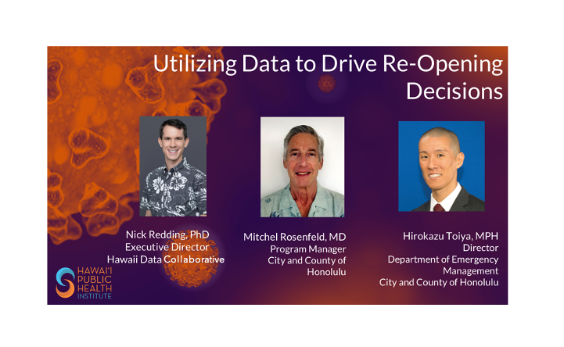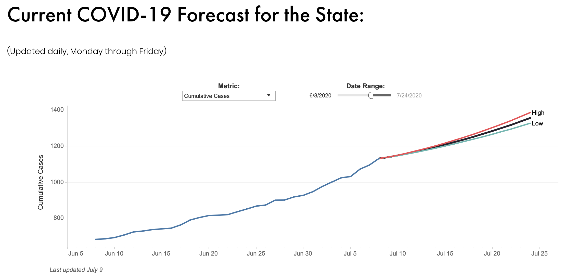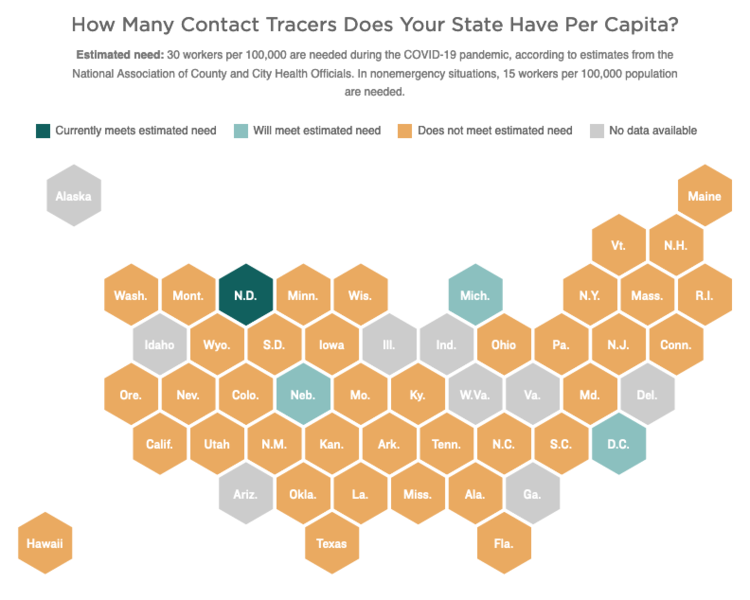News & Updates

HiPHI's COVID-19 Public Health Action Webinar: Utilizing Data to Drive Re-Opening Decisions
Hawaii Data Collaborative’s Executive Director, Nick Redding, joined the Hawaii Public Health Institute (HiPHI) and other panelists to discuss how COVID-19 data is informing the City and County of Honolulu’s re-opening strategy, tier system, and other related policy decisions. Some of the main points Nick highlighted were Hawaii Data Collaborative’s mission to elevate critical data to address Hawaii’s most pressing challenges; how the coronavirus pandemic amplified the urgency of that mission; and, some of the collaborative efforts that emerged to support the state’s response. Moderating the discussion was Stephanie Moir, from the HiPHI team; other panelists included Dr. Mitchel Rosenfeld, Program Manager with the City and County of Honolulu, and Hirokazu Toiya, Director of the City and County of Honolulu’s Department of Emergency Management.

HiPAM Launches New Daily COVID-19 Forecast Tool for Hawaii
The Hawaii Pandemic Applied Modeling (HiPAM) work group has launched a new public-facing tool that provides 14-day forecasts of new COVID-19 cases, hospitalizations and fatalities. The tool will be updated daily (Monday through Friday) based on the most current COVID data available in the state.

Fly on the Wall: A Glimpse into Developing a COVID-19 Modeling Tool for Hawaii
During a HiPAM convening, the group discussed how to respond to requests from local decision-makers for models and metric guidelines that would help determine when to lift local and domestic travel restrictions, as well as indicators of when restrictions may need to be re-imposed. The subsequent discussion demonstrated the complex array of factors that our state officials and senior executives must consider…

Dr. Thomas Lee, HI-EMA's Lead Modeler & Forecaster, Discusses Reopening Hawaii to Travel and More
Dr. Thomas Lee, Assistant Professor of Epidemiology at the University of Hawaii at Manoa, also an US Army Medical Officer from the 1984th US Army Hospital Pacific, 9th Mission Support Command, currently serving as lead modeler and forecaster for Hawaii’s Emergency Management Agency (HI-EMA) COVID-19 Emergency Response Team, discussed how he applies modeling to forecast and advise policymakers in their decisions, the potential and efficacy of testing and screening of inbound travelers, a basic explanation of “R naught,” and more.

HiPAM Chair, Dr. Victoria Fan, on the Honolulu Star-Advertiser's COVID-19 Care Conversation
Dr. Victoria Fan, Chair of the Hawaii Pandemic Applied Modeling (HiPAM) Work Group, appeared on the Honolulu Star-Advertiser’s COVID-19 Care Conversation to discuss the HiPAM Work Group, why modeling tools driven by Hawaii-specific data are critical, and the importance of testing visitors and contact tracing efforts as part of reopening Hawaii to inbound travelers.

A Missing Piece to Hawaii’s COVID-19 Response: The Hawaii Pandemic Applied Modeling Work Group
The Hawaii Pandemic Applied Modeling (HiPAM) Work Group originally formed out of a collective concern that our state’s decision makers lacked a Hawaii-specific, data-driven modeling tool to inform their decisions in response to COVID-19. Originally comprised primarily of academics and faculty from the University of Hawaii at Manoa, HiPAM has grown to include representatives from the Hawaii Department of Health, major local hospitals, and community nonprofits focused on Hawaii health and well-being.

E Komo Mai: How Do We Reopen Hawaii to Travel?
Getting the visitor industry back on its feet is one of the state’s top priorities. But how? Given what we know about the virulence of COVID-19, the risk of future outbreaks is clearly tied to movement of people and the introduction of large populations from outside the state.

Small Business May Play a Not-So-Small Part in Restarting Hawaii's Economy
The two largest industries in Hawaii by number of workers—accommodation and food services and retail trade—have been among the hardest hit by the economic impacts of COVID-19. The effect on those two industries was overwhelmingly felt by small businesses, which contribute billions of dollars to Hawaii’s economy each year.

Anonymized Testing Outcomes Database (ATOB) Could Increase Precision of Reopening Policies in Hawaii
An anonymized testing outcomes database (ATOB) that provides daily aggregated counts of asymptomatic as well as symptomatic cases could save Hawaii an additional $300 million in economic costs over non-ATOB reopening strategies.

Finding the Trade-Off Sweet Spot: Relatively Modest Health System Investments Could Reduce Hawaii’s Economic Losses by Billions
We used our Hawaii Population Model to explore the interplay between the medical resources needed to combat COVID-19 and their associated economic impacts, given current conditions over the next two months. We ran scenarios of every possible combination of health system parameters, with their associated economic costs, iterating and reiterating the model until every combination of infection mitigation strategies had been tested.

Contact Tracing versus Contact Tracking
Among the many new terms that have crept into our daily language, contact tracing has become one of the most frequently heard in connection with COVID-19. Contact tracing is a traditional public health strategy that has been used to fight the spread of everything from the common flu to the AIDS virus. We often hear public health officials talk about the need to employ contract tracing to not only get the current pandemic under control but to keep the virus from flaring up once we start to reopen cities and states.
